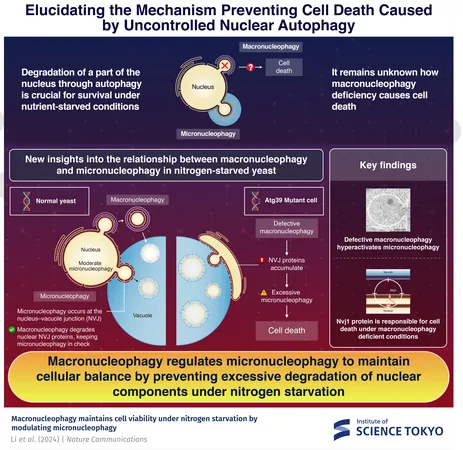
Unlocking the Secrets of Macronucleophagy: The Key to Yeast Survival in Nitrogen Starvation!
2025-01-08
Author: Li
Introduction
In the realm of cellular biology, autophagy stands out as the body's vital housekeeping process, akin to a meticulous janitor ensuring every organelle and protein within the cell is accounted for and in good condition. This crucial mechanism, present in all forms of life—from humble yeast to complex mammals—plays a pivotal role in maintaining cellular balance and homeostasis. Disruptions in this delicate system have been linked to an array of diseases, including neurodegenerative disorders like Alzheimer’s and Parkinson’s, as well as various cancers.
Understanding Autophagy
But did you know that autophagy isn't just one process? It manifests in several forms, each specialized in its method of transporting cellular debris to lysosomes or vacuoles, which act as the cell's recycling and waste management centers. Among these forms, macronucleophagy has emerged as a fascinating area of study, particularly its role in the survival of the model organism Saccharomyces cerevisiae, or baker's yeast, during nutrient deprivation.
Groundbreaking Research
A groundbreaking study recently published in *Nature Communications* has unveiled critical insights into how macronucleophagy helps yeast endure nitrogen starvation. Led by talented Ph.D. student Ziyang Li and his team from the Institute of Science Tokyo, the research pinpoints the relationship between macronucleophagy and the survival of yeast cells under stress conditions. Their findings indicate that when the process of macronucleophagy is impaired, it leads to uncontrolled activation of another autophagic process known as micronucleophagy, ultimately resulting in cell death.
What is Macronucleophagy?
So, what exactly is macronucleophagy? In this autophagic pathway, part of the nucleus bulges out, is encased within a vesicle termed an autophagosome, and is subsequently shuttled to the vacuole for degradation. This method contrasts sharply with micronucleophagy, where direct contact occurs between the nuclear surface and vacuole, allowing the nucleus to invaginate and be dismantled at nuclear-vacuole junctions.
Research Findings
Li's team previously established that yeast mutants lacking functional macronucleophagy (specifically atg39Δ mutants) succumbed rapidly to nitrogen starvation. Their detailed analyses revealed that these mutants experienced an abnormal surge in micronucleophagy, a phenomenon that positively correlated with cell death rates. The investigation highlighted a vital nuclear surface protein called Nvj1, essential for maintaining the connection between the nucleus and vacuole, which accumulates when macronucleophagy falters—and subsequently amplifies micronucleophagy.
Implications of the Research
Encouragingly, Li noted, “Blocking micronucleophagy almost completely halted cell death in the absence of macronucleophagy, while intensified micronucleophagy worsened survival rates.” This pivotal discovery emphasizes the notion that macronucleophagy actively regulates micronucleophagy to prevent excessive degradation of nuclear components, thereby preserving both nuclear and cellular integrity.
Conclusion
This illuminating research not only elucidates the complex interplay between different autophagy forms but also underscores their collective significance in sustaining life during challenging conditions. Future explorations in this domain could yield profound implications for medical science and biotechnology, forging paths toward innovative treatments for diseases linked to autophagy dysfunction.
In short, the revelation of how macronucleophagy regulates micronucleophagy highlights the intricate designs of cellular processes that govern survival. As researchers continue to unravel these biological mysteries, who knows what other vital insights await us on the horizon? Stay tuned for groundbreaking developments in the field of cellular autophagy!

 Brasil (PT)
Brasil (PT)
 Canada (EN)
Canada (EN)
 Chile (ES)
Chile (ES)
 Česko (CS)
Česko (CS)
 대한민국 (KO)
대한민국 (KO)
 España (ES)
España (ES)
 France (FR)
France (FR)
 Hong Kong (EN)
Hong Kong (EN)
 Italia (IT)
Italia (IT)
 日本 (JA)
日本 (JA)
 Magyarország (HU)
Magyarország (HU)
 Norge (NO)
Norge (NO)
 Polska (PL)
Polska (PL)
 Schweiz (DE)
Schweiz (DE)
 Singapore (EN)
Singapore (EN)
 Sverige (SV)
Sverige (SV)
 Suomi (FI)
Suomi (FI)
 Türkiye (TR)
Türkiye (TR)
 الإمارات العربية المتحدة (AR)
الإمارات العربية المتحدة (AR)